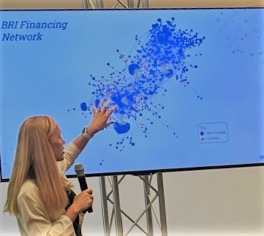Joosse’s expertise on networks shines at GRI China conference
 Public Policy Senior Lecturer Alexandra “Alex” Joosse and collaborators recently presented research using network analysis to study China’s Belt and Road Initiative, a global set of infrastructure investments that has become a key instrument of Chinese foreign policy.
Public Policy Senior Lecturer Alexandra “Alex” Joosse and collaborators recently presented research using network analysis to study China’s Belt and Road Initiative, a global set of infrastructure investments that has become a key instrument of Chinese foreign policy.
Prof. Joosse’s presentation with her team took place in June at a conference on China’s global influence sponsored by the W&M Global Research Institute (GRI) and AidData. Michael Tierney, the GRI director and Hylton Professor of International Relations, called the presentation “the most exciting piece of new research I saw” at the conference.
During the Belt and Road Initiative (BRI) era that started in late-2013, China emerged as the world’s single largest official development financing benefactor. With US$85 billion in official commitments every year, it is now outspending the United States on a more than 2-to-1 basis and other major bilateral donors like Japan and the United Kingdom by even larger margins.
Because China does not participate in any global systems established for maintaining transparency around donors’ overseas development financing activities, its growing role in the world of development finance is largely shrouded in mystery. Prof. Joosse and her co-authors, including Ammar Malik (Adjunct Lecturer of Public Policy and Senior Research Scientist at AidData), and Thai-Binh Elston (BA Public Policy ’20), and Sheng Zhang, drew back the curtain on the participation of non-Chinese financiers of BRI projects in their presentation entitled “Networks of the Belt & Road: The Hidden Role of Financial Brokers.”
Their work drew substantial interest from conference attendees because of its use of Social Network Analysis, a tool that Professor Joosse teaches to undergraduate majors and Master’s in Public Policy students, to better understand the structure of the BRI financing network.
In particular, the paper uses Social Network Analysis to find non-Chinese financiers of the BRI that act as brokers, or actors that sit in structural locations in a network that allow them to connect otherwise disconnected groups of actors. Brokers are important in this network because of the informational benefits that accrue to an actor that is able to connect to diverse other actors.
The team found that 66% of the top 20 brokers in this network are private commercial banks, a notable fact given that profit-maximizing entities have not traditionally been important players in the world of development finance. Moreover, projects involving the top-20 brokers have 43% greater loan commitment values than average and are 19 times more likely than average to be financed through syndicated loans. These findings provide evidence of Beijing’s shift to more bankable and higher risk projects.














